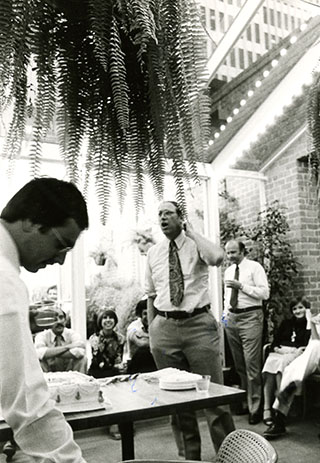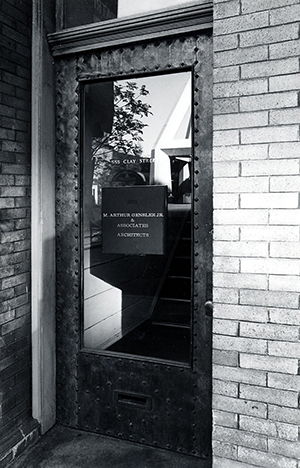 Art Gensler, FAIA, FIIDA, RIBA, founded Gensler in 1965 and is credited with turning the design of interiors into a multi-disciplinary global practice with more than 6,000 professionals in 48 offices around the world. Twenty years ago, Byron Kuth and I cold-called Art and invited him to lunch at Mama’s on Washington Square in North Beach. We sought his advice on how to grow our practice. He didn’t know us, but he accepted. He was very generous and helped us to strategize on diversifying project types, which was a challenge given our experience and small practice at the time.
Art Gensler, FAIA, FIIDA, RIBA, founded Gensler in 1965 and is credited with turning the design of interiors into a multi-disciplinary global practice with more than 6,000 professionals in 48 offices around the world. Twenty years ago, Byron Kuth and I cold-called Art and invited him to lunch at Mama’s on Washington Square in North Beach. We sought his advice on how to grow our practice. He didn’t know us, but he accepted. He was very generous and helped us to strategize on diversifying project types, which was a challenge given our experience and small practice at the time.
Today, Kuth Ranieri Architects and Gensler are five years into a joint-venture design partnership on San Francisco Airport’s Terminal 1, with the first seven gates due to open in July of this year. We’re also working with Gensler on a second project, the Golden State Warriors’ Chase Center in San Francisco, as associate interior architect for the main and theater lobbies, as well as associate architect on the arena’s esplanade, a retail street that wraps its base. For arcCA Digest’s theme for this quarterly issue, “Staying In Business,” Byron and I sat down with Art once again so we could share his sage advice with our colleagues.
—Liz Ranieri
Liz Ranieri: How has the firm weathered the ups and downs of the economy?
Art Gensler: We’ve been through a number of major downturns. We have diversified practice areas. That means that we do retail and hospitality and sports and workplace and office buildings and education. We’re starting to do a little housing. The diversification helps through the up and down cycles of the economy.
We learned that if we’re really good at helping our clients and build long-term relationships, they need us when they’re going up and they need us when they’re going down. We also have master service agreements with about 200 companies, where they just pick up the phone and say, “Do it.” We’ve already negotiated the contract, the deal and the structure.
We have tried to create a firm that will go on forever as a permanent business partnership. We’re not a partnership, we’re a corporation, but for all intents and purposes, we act like a partnership. To accomplish that, you need to have a flow of people that step into senior roles and take on total leadership.
We are in the fourth generation of leadership at the firm. I started it, and four of us actually ran it. Then a group of six was running it, and now five. With transition, people go through two years of training before they take over. They are shadowing the leaders.
We have two co-CEOs, which helps because then it’s not just one person with the whole load. And they can balance each other. You need somebody to talk to.
Nobody likes to let good people go because of a downturn. We’ve learned that if you’re going to do it, do it early so the people can get to other places where they can find jobs.
Another important thing we did was to create diversified locations, so that we’re not all sitting in San Francisco or New York. We’re now in 50 locations. I’m not suggesting that all firms should become multi-office. But diversify the services or the geography. For example, don’t just focus on residential, but maybe on residential and civic buildings or museums. Have at least one secondary market for counter-cyclical markets.
Liz Ranieri: When you wanted to open in a new location, did you wait until you got work there?

Art Gensler: Yes. We would finish one major project there. Then a team is sent in, to make that project terrific and to make a statement in the community. They come to know the building department, the contractors, and all the things that you need to know about a community. Because we don’t buy firms, we have to transfer our own people into those places. And then we hire local people from around the country or world.
We go in on a major project, or a major client says, “I need you here.” We know their standards, their approach, how they do things. We know how they pay their bills and what their contract requirements are and how they work with contractors. And so it’s easier for them to work with us in their far-flung offices.
We think of ourselves as a one-firm firm. That’s a concept that McKinsey & Company helped us develop: instead of offices being silos of profit centers, controlled by one or two people, we have one firm, one giant family. If you’re in the Sydney office and things are really slow in Australia, your office can work on projects in Singapore and Tokyo.
Byron Kuth: Gensler also does projects in a wide range of sizes—what’s your philosophy around that?
Art Gensler: People think that if you’re a big firm, you should just do big projects. I don’t buy into that philosophy. We’ve done everything from the Shanghai Tower, the second tallest building in the world, to a wine label.
So for example, some people have said, “Why would you do 3,000 Gap stores?” It might as well be us. We’re in the service business, so if the client needs something and it requires good design, then we do it. And around the world, it’s the same way. We have the flexibility to fill in the holes, even when we’re busy, if a project stops for two or three weeks, or it’s held up by permitting or funding. Most people here are working on four or five projects—one primary, maybe two. The other projects, you fill in and help out.

Liz Ranieri: There are many smaller and mid-sized firms. Do you think that Gensler’s one-firm firm philosophy is scalable to them?
Art Gensler: I think it’s scalable. When the designers talk about “my building,” they’re saying, “I want my statement out there.” And we get the chance to do a lot of statements. But we also do a lot of what I call background projects. They need to be done well. They’re not going to be on the cover of an architectural magazine. But they’re very important to the client and the community.
Byron Kuth: It seems fashionable right now for architecture firms to acquire other firms. What are your thoughts on acquisitions as a way to grow?
Art Gensler: It’s a mistake. If a firm is up for acquisition, I have a few guesses as to why. One, the principals want to retire soon but have made no plans to get out financially. That’s the most common reason. In other cases, a firm sees the advantage of adding diversity of offerings to expand the range of what they can provide clients. And sometimes, a firm will want to sell itself and become part of as big a group as they can.
But my experience tells me that most organizations—I can’t speak for all of them—don’t know how to integrate a firm. It’s hard to integrate. Even if you rip their name off the wall, if they’re the same people working in their office without your people running it, then the merger doesn’t work.
Byron Kuth: How do you manage 6,000 people?
Art Gensler: We share everything. We respect each other. And we support each other. But we don’t try to dictate to the offices. We have standards, of course. If you sit down at a computer in any Gensler office in the world, the screen will look identical. The forms will be identical. But the design approach is different.
And we have a huge number of meetings. I just finished talking over the weekend to our new senior associates—they’ve been here for three days from all over the world. There are 175 new senior associates. They are briefed on everything. But the most important thing is that they get to know the people in other offices. We have an unofficial rule that you don’t sit with people from your own office. You sit with people from other offices to get to know them, because you may need them. We have a Monday morning call-in, and somebody in San Diego says, “Dan, you’d better get somebody who can do high-end contemporary hotel interiors.” And somebody in Houston will say, “Oh, Judy’s free and she can do a really good job.”
We move people around a lot. We now have an international exchange program between offices. In today’s world, it’s important to have some international experience. But the whole idea is that we’re one group trying to do a good job for clients all over the world.

Byron Kuth: Gensler has expanded into branding, graphics, and other disciplines. How did that come about?
Art Gensler: I’ll tell you a story, because it sort of says everything about the firm. Twenty years ago, the firm was called Gensler and Associates Architects. I hired a man named John Bricker out of school to put signs on buildings—the name of the building, the address number, the exit signs, all that stuff. One day John said, “I’d like to talk to Gensler’s board of directors.” I asked him why, and he said, “I’ll tell you when I get there.” [Laughs] So the board came to town, and John said to them, “I’m having real trouble selling branding and graphics services to other architects and encouraging them to tell their clients about us, given the fact that I’m in an architecture firm, because they don’t think architects should do that stuff.”
I said, “What do you recommend?” And he said, “I want to change the name of the firm.” [Laughs] I said, “‘Gensler,’ I’m kind of attached to that. And we have a lot of associates and architects. I’m proud to be an architect. What would you call it, John?” He said, “Why don’t we just call it Gensler?” Then he said the magic words: “We can be a design firm, not an architecture firm.”
We haven’t gone into engineering, but we do furniture design and product design, we have a consulting group in the design world, we have people who keep data on occupancies. Today, clients are looking for one-stop shopping. Some clients want engineering too, but engineers are totally different from architects and other designers. I respect them immensely, but they think differently, act differently.
Liz Ranieri: Gensler’s transition from what was understood as an architecture firm to a full-service array of design departments seems like a pivotal change. How do you deal with so many talents?
Art Gensler: Clients used to say, “Well, I know you’re big, but we want the A team.” And so I said, “We don’t have B teams.” We are not a firm of one or two stars, it’s a constellation. And those people go from stars in our accounting department and human resources to our top architectural designer to our top interior designer. But everybody has to be a star in our firm. To keep 3,000 clients happy, you need a lot of stars.
Byron Kuth: As you look over the various sectors, what do you see coming in the future?
Art Gensler: There’s a huge change in retail. I don’t think anybody knows what that change is, but it’s going to be dramatic. There is going to be an enormous amount of work in adaptive reuse of suburban malls. One, they are going to sit there empty. Two, they’re going to get knocked down and somebody starts over again. Or three, they’re going to figure out a way to adapt them and make them viable again but in a different format. That’s an interesting opportunity. You also see Amazon and Apple doing stores with no clerks. How do you lay it out? How do you design it? How are you going to use artificial intelligence?
The workplace is always interesting because it keeps changing. We’ve gone from the cellular office to the open plan to a blend. One hundred percent open plan was not a good idea. In our own new space nobody has an office except me, but there are hundreds of conference rooms and meeting spaces. We have free address, so people can sit down anywhere and punch their number in, and that’s their home for a day or a week or forever.
I think low-cost housing is going to be big—this is probably going to be modular in some way.
Byron Kuth: So you’re starting to get into that sector?
Art Gensler: At the moment, we’re working with a company that does hotels. And believe it or not, all the units are made in Poland and shipped to the United States.
Liz Ranieri: Any final words of wisdom?
Art Gensler: The point is, it was never about one person. It was about providing services to clients who valued design to help them accomplish their goals.
From arcCA DIGEST Season 2, “Staying In Business.”





